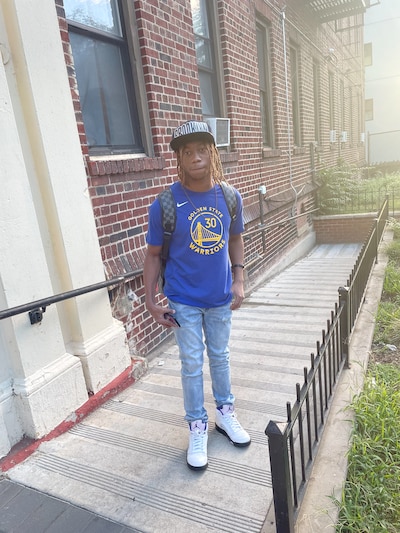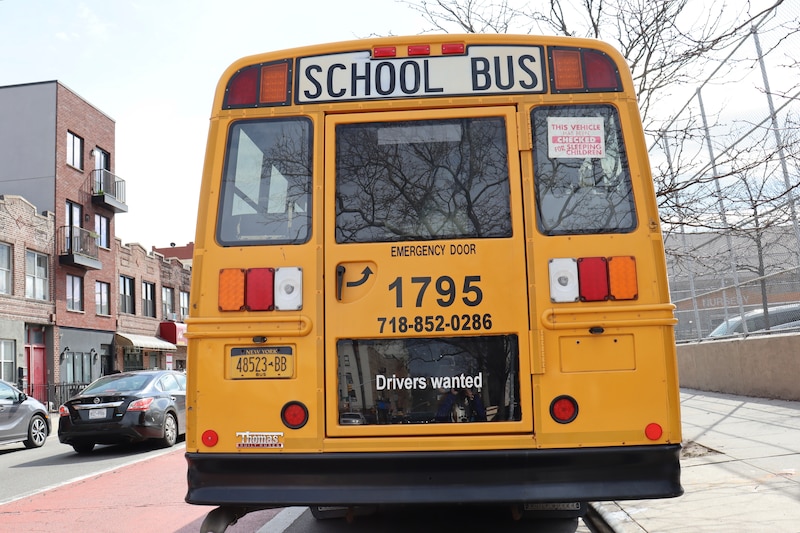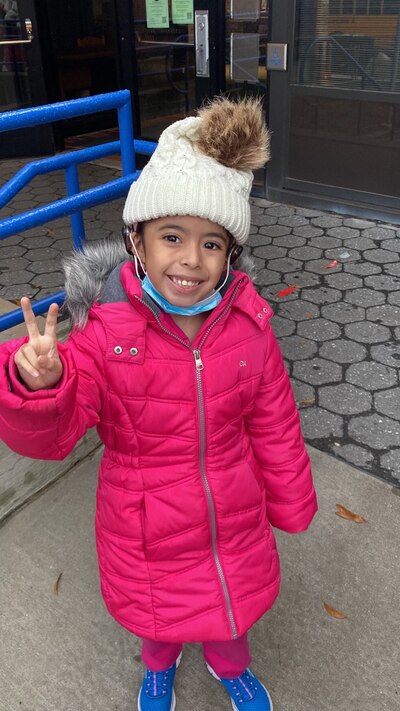One morning in late October, 8-year-old Eric Vilchis’s school bus picked him up on Bushwick Avenue at 7:30 a.m. About three and a half hours later, his mother, Araselis Pedrasa, received a phone call from his school: Her son had never arrived.
Panicked, the Brooklyn mom began calling the bus driver and bus attendant. Neither answered their phones.
“We didn’t know where the bus was,” she said in an interview translated from Spanish.
Pedrasa learned later that the bus had never left Brooklyn. A new bus driver had gotten lost and eventually “just shut down and sat there,” said Laura Cruz, the director of pupil personnel services at Eric’s school in Queens, the Lexington School for the Deaf. Cruz reached out to the bus company during the incident.
About 150,000 students in New York City rely on the city’s yellow buses to get to school each day, and 43% of them are students with disabilities. Many of those students are guaranteed bus service in their individualized education programs, or IEPs, legal documents that outline services and accommodations.
Yet parents and caregivers across the city say the long-standing problem of delayed, overcrowded, or missing buses is contributing to chronic absenteeism in schools and causing students to miss out on hours of instruction. They say the problem has only gotten worse amid a major shortage of bus drivers. About 300 yellow school bus driver positions in New York City were unfilled as of December.
Delays were nothing new for Eric. He typically arrives at school around 10:30 a.m., about two and a half hours after the day starts, his school said. But on that October morning, when his bus driver never left Brooklyn, Eric sat on the bus for six hours, arriving at his school at 1:40 p.m., his mother said.
“He had nothing to eat. No water. Nothing,” Pedrasa said.
About 350 school buses in New York City are delayed each day, according to data released by the city in October. In that month, 14,000 school delays were reported, more than any other month since 2017. On average, the buses showed up 41 minutes late.
As of March 1, almost 63,000 school bus delays had been reported for this school year, an average of over 10,000 each month. Of these, the majority were buses for students with special needs, according to public data.
Some parents and advocates believe the bus problems directly contribute to chronic absenteeism in schools — that rate that reached 40% in the 2021-22 school year, according to the department of education. A student is considered chronically absent if they miss 10% or more of school days.
Students with disabilities were significantly more likely to miss school. In Brooklyn, where Eric lives, about half of students with disabilities were chronically absent compared to about a third of their general education peers.
The city says that if a student is absent or late due to a transportation issue, their absence is coded differently in the attendance system to ensure students are not penalized. But absences due to busing issues are still included in citywide chronic absenteeism rates — and the children still miss out on hours worth of instruction.
Janyll Canals, an attorney at Advocates for Children, echoed this point. “Busing does have an impact on chronic absenteeism for students with special needs,” she said.

April Blakely’s 17-year-old son, Josiah, wakes up at 6 a.m. each morning to catch his 7 a.m. school bus, a service mandated by his IEP.
“There were times I waited downstairs until 8, 8:30, 9,” she said. “One morning he was late because they didn’t have a bus. He got picked up at 10,” two hours after his school day officially began. Most days he arrives at school just before 9 a.m., missing out on a hot breakfast and his first period.
Blakely said her son has missed about 11 school days so far this year due to transportation issues.
She tries to take Josiah to school by public transportation but is not always able to. This journey takes about two hours round trip and involves the Long Island Railroad, a subway, and a bus.
Students with disabilities disproportionately affected
The education department contracts with 52 different bus companies. These buses cover around 9,000 routes and pick up 150,000 students. Routes zigzag through the city, grouping students from different neighborhoods and schools all on the same bus.
Eligibility for yellow buses depends on grade level, walking distance, and special accommodations. Once a student reaches seventh grade, they are only eligible for a yellow bus if they have an IEP or other accommodation. While about 20% of all New York City students have IEPs, 43% of all students who receive busing have disabilities.
The city’s website states that students as young as kindergarten, traveling out of borough for school, can legally spend up to 115 minutes on their buses each way. Some students have IEPs that mandate the maximum amount of time the child is able to spend on a bus for cognitive and medical reasons, and several families say the buses often violate these limits.
At the start of this school year, the Office of Pupil Transportation received 18,000 complaints from families who reported missing or delayed buses and bus routes, according to a report released by the New York City Council.
City officials say they have been working toward a solution, trying to make it easier for people to become bus drivers and creating an app that they say will eventually be able to track all buses and design more efficient routes. In the meantime, they’re paying rideshare apps, like Uber, to take some students to school each morning. Department of education officials were unable to provide data on how many students use the rideshare option or how much money has been spent on these rides so far.

“Every student and family deserve the support and resources they need to safely travel to and from school,” said education department spokesperson Jenna Lyle. “We are committed to providing quality transportation and outstanding service to the approximately 150,000 students we transport to and from school each day.”
Some parents aren’t willing or able to wait for the city’s solutions. Sara Catalinotto and her husband began to get involved in school bus transportation advocacy in 2008, frustrated by their then-second-grade son’s “long long long” commute from one end of Manhattan to the other.
Catalinotto said a group of parents, mostly from the same school, were all comparing notes and trying to figure out why their routes were so convoluted. By 2010, fed up with the city’s alleged incompetence and inaction, they founded Parents to Improve School Transportation, or PIST.
Twelve years later, Catalinotto still runs PIST and is in near-constant communication with parents and bus drivers across the city. She said some days she doesn’t want to open her email because reading all of the accounts from families makes her cry.
Catalinotto’s group has begun petitioning for a “School Bus Bill of Rights,” to “empower a panel of parents/caregivers, disability advocates, educators, and bus workers over pupil transportation policy decisions.” They also provide families across the city with resources, such as a pamphlet with tips to navigate the intricate bureaucracies of the Office of Pupil Transportation.
Rideshare apps, an imperfect solution to busing gaps
Even as advocates and city officials say they are working on long-term solutions, many families say the city’s short-term solutions — Ubers, taxis, and other rideshare options — are inaccessible.
Diana Sombrano, another parent at Lexington School for the Deaf, said her daughter’s bus route has no driver. One morning a bus did show up, but it was so overcrowded that her daughter, Brittany, could not fit, she said.
“I was standing at the door looking inside the bus, and I was like, ‘It’s impossible,’” said Sombrano. “I don’t want my daughter on a bus like that.”

After contacting the Office of Pupil Transportation, the office offered her daughter prepaid rideshare trips to and from school. But Sombrano would have to accompany Brittany in the car, both ways. The car is supposed to take the parent to their child’s school and then back home or work— but it’s hard for many working parents to make the roundtrip.
According to the education department’s website, this prepaid service is only offered to students who are eligible for curb-to-school transportation if their route is “out of service.”
Cruz, who works at Lexington School for the Deaf, said that in reality, this option is limiting. “The problem is that a family member has to accompany the students, and a lot of families can’t. They gotta go to work,” she said. “We offered the car share to like 30 families.”
Of those families, the Sombranos were the only ones able to utilize it.
While Sombrano ultimately secured prepaid trips to and from school for her daughter, she said it was a frustrating process requiring repeated follow up with the pupil transportation office.
Lori Glick, a social worker at the school, said this experience is common. She said the school sent a list of students eligible for the rideshare option to the office on Nov. 21. By mid-December, she still hadn’t heard back.
In an emailed statement, an official at the department of education said, “NYC Public Schools works to proactively identify and notify any families who may be eligible for rideshare services. If there are any families who were not contacted proactively and they believe they may be eligible for rideshare, we encourage them to reach out to their school to request the service.”
Eventually, the city assigned the Sombranos a taxi service, which now transports them to and from school each day.
Even that solution is imperfect.
“Sometimes the taxi driver is late so I have to call them every morning and remind them,” Sombrano said. “It’s ridiculous.”
Bus delays have been such a common occurrence that the administrators at Lexington have created an after-school schedule to ensure at least one adult is always available to sit with kids until their late buses arrive.
Eric, the student who was stuck on his bus for six hours in October, is still waiting for a permanent bus driver to be assigned to his bus. His parents do their best to get him to school on their own each morning and, in the afternoons, he sits with the administrator on duty, often for hours, waiting for his ride home.
Amanda Geduld is a Columbia University Stabile Investigative Fellow.
Correction: The city’s rideshare program does take parents to or from work after school drop off or pick up.

